Monthly Archives: October 2022
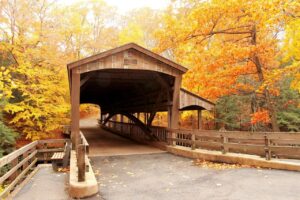
 I’m sure most of us have seen a covered bridge…at least in pictures. Most people think of them as being nostalgic, and I do too. They remind me of times long gone, but why were bridges covered in the first place? It wasn’t to lend a romantic flair to the bridge, you know. No, the real reason for covered bridges actually traces back to what the bridge is made of. Wooden structures then and now are exposed to harsh weather and subject to wear and tear. Covering the bridge does two important things. The cover protects the wooden deck…the surface that people and vehicles travel on. It also protects the truss system, which is the lattice framework under and around the bridge that supports the deck, helping the structure last longer. The roof and side elements were replaceable as long as the support structure remained strong. If the support structure weakens, the bridge will have to be rebuilt, because rotting wood cannot be made strong again. This is one of the main reasons that covered bridges have slowly given way to steel bridges over time. Steel structures hold up years longer than wood.
I’m sure most of us have seen a covered bridge…at least in pictures. Most people think of them as being nostalgic, and I do too. They remind me of times long gone, but why were bridges covered in the first place? It wasn’t to lend a romantic flair to the bridge, you know. No, the real reason for covered bridges actually traces back to what the bridge is made of. Wooden structures then and now are exposed to harsh weather and subject to wear and tear. Covering the bridge does two important things. The cover protects the wooden deck…the surface that people and vehicles travel on. It also protects the truss system, which is the lattice framework under and around the bridge that supports the deck, helping the structure last longer. The roof and side elements were replaceable as long as the support structure remained strong. If the support structure weakens, the bridge will have to be rebuilt, because rotting wood cannot be made strong again. This is one of the main reasons that covered bridges have slowly given way to steel bridges over time. Steel structures hold up years longer than wood.
A covered bridge is a timber-truss bridge with a roof, decking, and siding, so most covered bridges actually look like a building over water. They are an almost complete enclosure, with the exception of their two ends, and sometimes windows. Uncovered wooden bridges typically have a lifespan of only 20 years because of the effects of rain and sun, but when a bridge is covered, it could last over 100 years. In fact, the oldest covered bridge in the United States is Hyde Hall Covered Bridge, which is on the grounds of Glimmerglass State Park in Cooperstown. It was built by George Clarke in 1825 on what was then the private property of Hyde Hall.
Nevertheless, while covered bridges last a long time, in the United States, only about 1 in 10 survived the 20th century. It wasn’t because they were dilapidated, but it was due to deliberate replacement, neglect, and the 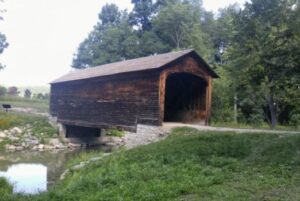
 high cost of restoration. Covered bridges have a long history, and they can be found throughout Europe and especially North America in places like New England, the Mid-Atlantic and the regions around the Great Lakes…mainly because these areas are very wooded, and so the building material there is plentiful. I think it’s rather sad that the covered bridges have almost become extinct…such a loss to history.
high cost of restoration. Covered bridges have a long history, and they can be found throughout Europe and especially North America in places like New England, the Mid-Atlantic and the regions around the Great Lakes…mainly because these areas are very wooded, and so the building material there is plentiful. I think it’s rather sad that the covered bridges have almost become extinct…such a loss to history.
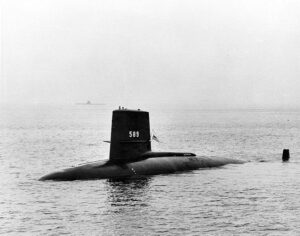
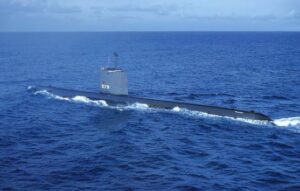 USS Scorpion (SSN-589) was a Skipjack-class nuclear-powered submarine that served in the United States Navy, and the sixth vessel, and second submarine, of the US Navy to carry that name. It was also the fourth nuclear powered submarine to mysteriously go missing in 1968. Scorpion was lost with all its crew, on May 22, 1968. Scorpion is one of two nuclear submarines the US Navy has lost, the other being USS Thresher. The other nuclear-powered submarines to go missing in 1968 at the height of the Cold War were Israeli submarine INS Dakar, the French submarine Minerve, and the Soviet submarine K-129. At the time Scorpion went missing when she was sent to surveil the Soviet submarine K-129, which had apparently already gone missing earlier in the year. The wreckage of USS Scorpion is still at the bottom of the North Atlantic Ocean…with all its armaments and nuclear engine.
USS Scorpion (SSN-589) was a Skipjack-class nuclear-powered submarine that served in the United States Navy, and the sixth vessel, and second submarine, of the US Navy to carry that name. It was also the fourth nuclear powered submarine to mysteriously go missing in 1968. Scorpion was lost with all its crew, on May 22, 1968. Scorpion is one of two nuclear submarines the US Navy has lost, the other being USS Thresher. The other nuclear-powered submarines to go missing in 1968 at the height of the Cold War were Israeli submarine INS Dakar, the French submarine Minerve, and the Soviet submarine K-129. At the time Scorpion went missing when she was sent to surveil the Soviet submarine K-129, which had apparently already gone missing earlier in the year. The wreckage of USS Scorpion is still at the bottom of the North Atlantic Ocean…with all its armaments and nuclear engine.
The Cold War is a term commonly used to refer to a period of geopolitical tension between the United States and the Soviet Union and their respective allies, the Western Bloc and the Eastern Bloc. The first phase of the Cold War began shortly after the end of World War II in 1945. The United States and its allies created the NATO military alliance in 1949 in the apprehension of a Soviet attack and termed their global policy against Soviet influence containment.
Following World War II, tensions were running high between world powers. It is thought that if there was ever a time when a real possibility of a nuclear attack existed, it was during the Cold War. This meant that countries were frantically looking for any advantage they could use to take over their competitors. One way to watch the other countries was to Surveil beneath the waves where they could be more hidden. This surveillance included the use of submarine crews. That, of course, explains the reason for mysterious disappearance of four subs from four different countries virtually at the same time.
The first disappearance was the INS Dakar from Israel, which went down just east of Crete on January 25, 1968. Dakar’s wreckage was found in 1991, but no official cause for the sinking was determined. Next, The French sub Minerve disappeared about an hour outside of Toulon on January 27, 1968. That wreckage was found in 2019, and it showed the hull had separated into three sections. When the French government made the decision to leave the wreck, any chance of answers was eliminated. The Soviet K-129 disappeared earlier in the year, so maybe USS Scorpion was looking for it. Nevertheless, on May 22, 1968, the disappearance conspiracy of 1968 was brought to a close, when USS Scorpion. The submarine would not be fount until October of 1968. The Navy looked into the disaster, but in the end the official court of inquiry said the cause of the loss could not be determined with certainty. Still, there are several theories on what might have happened. One centered around a malfunction of a torpedo. Others suspected poor maintenance may have been the culprit, citing the rushed overhaul.
That was the last report anyone heard about the submarine. After decades of research and investigation, the US Navy has never changed its report that a catastrophic event caused the sinking. Nevertheless, there are those who believe the Scorpion was taken out by the Soviets in retaliation for perceived attack on the K-129 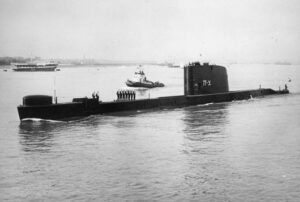
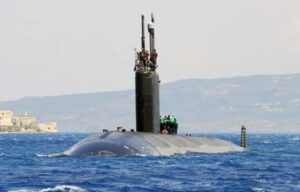 submarine earlier in the year. Neither country will admit or deny any direct action relating to the submarine sabotage, but something happened during the first half of 1968. Four nuclear-powered submarines, from four different countries just don’t start sinking for no reason, and yet, no reason was ever determined. They just sunk.
submarine earlier in the year. Neither country will admit or deny any direct action relating to the submarine sabotage, but something happened during the first half of 1968. Four nuclear-powered submarines, from four different countries just don’t start sinking for no reason, and yet, no reason was ever determined. They just sunk.
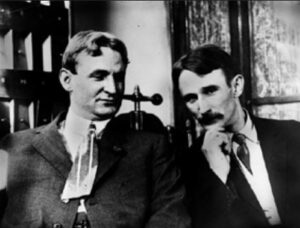
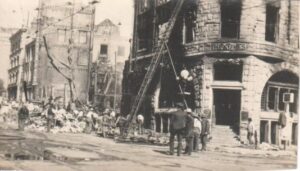 The battle between those who support unions and those who do not, has gone on for a long time, and each has its pros and cons. Unions help employers create a more stable, productive workforce…one in which workers have a say in improving their jobs. Unions help bring workers out of poverty and into the middle class. In fact, in states where workers don’t have union rights, workers’ incomes are lower. So, it is always “in the employer’s best interest” not to have a union, but really not in the best interest of the workers, for whom the working conditions can be sub-par, and even dangerous. Because of that, the battle between the two sides has raged on for many years.
The battle between those who support unions and those who do not, has gone on for a long time, and each has its pros and cons. Unions help employers create a more stable, productive workforce…one in which workers have a say in improving their jobs. Unions help bring workers out of poverty and into the middle class. In fact, in states where workers don’t have union rights, workers’ incomes are lower. So, it is always “in the employer’s best interest” not to have a union, but really not in the best interest of the workers, for whom the working conditions can be sub-par, and even dangerous. Because of that, the battle between the two sides has raged on for many years.
In the early 1900s, one such situation resorted to violence, and that violence came to a boiling point on October 1, 1910, when a suitcase bomb ignited a massive explosion that destroyed the Los Angeles Times building in the Los Angeles’ downtown area. The explosion killed 21 and 100 more people, all of whom were workers for the Los Angeles Times, who were working late to put out an early afternoon edition of the paper to celebrate the results of the Vanderbilt Cup auto race. Since Los Angeles Times publisher Harrison Otis was an extreme opponent of unions, he believed that the bomb was directed at him. With that in mind, he hired the nation’s premier private detective of that time, William J Burns, to crack the case. Otis was now a quiet opponent to unions, and in fact, he printed numerous editorials against unions. He was also the leader of the Merchants and Manufacturing Association, a powerful group of business owners with extensive political connections…and very much anti-union.
As Burns investigation progressed, it led him to the Bridge and Structural Iron Workers Union and their treasurer, John J McNamara. McNamara’s brother, James B (JB) was discovered to be the actual bomber. He left a suitcase with a dynamite bomb near barrels of flammable printer’s ink between the Los Angeles Times Building and the Times annex, known as “Ink Alley”, which contained the paper’s printing press. The dynamite had a detonator connected to a mechanical windup clock, set to close an electric battery circuit at 1:00am, and set off the explosion. JB left similar bombs, also set to explode at 1:00am, next to the homes of both Times publisher, Otis and Felix Zeehandelaar, secretary of the M and M. He then boarded a train to San Francisco so he could have credible evidence that he was out of town when the bomb at the Times building went off.
In April 1911, after Burns got a confession out of Ortie McManigal, who had allegedly been the intermediary between McNamara and two bomb experts, he personally arrested John McNamara and his brother, James in Indiana. Burns also managed to get the brothers to California, without any legal authority, where they were to be prosecuted.
In an immediate response, union members and left-wing supporters alike, rallied around the McNamara brothers. They quickly raised a large defense fund, and union representatives pleaded with Clarence Darrow to take the case. Darrow, who was the best defense attorney America had to offer at that time. He was noted for getting “Big Bill” Haywood, the union leader of the Industrial Workers of the World, off on murder charges in Idaho a few years earlier. They offered him $50,000, and he found that he just couldn’t resist, so he took the case. As the case progressed, Darrow began to realize that the McNamara brothers were guilty, and as evidence mounted, he worked a deal in which JB McNamara pled guilty and received life in prison, as opposed to the death penalty. Despite repeated attempts by left-wing labor leaders and certain politicians to win his release, he refused to file any parole requests. James B (JB) McNamara died of cancer in San Quentin on March 9, 1941. John J (JJ) McNamara received 17 years in prison. JJ McNamara left prison after nine years, and the 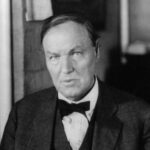
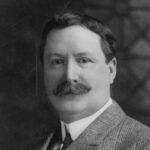 Iron Workers’ union welcomed him back as an organizer. He was convicted of threatening the destruction of a building unless the contractor hired union members and was sent back to prison. Released once more, the union discovered that he had embezzled $200, and fired him. JJ spent the rest of his life drifting from job to job, and died in Butte, Montana on May 8, 1941. In all, 40 additional co-conspirators were convicted of various crimes and served various sentences, but it was always thought that the McNamara brothers were the ring leaders, and that they others had bit parts in the attack.
Iron Workers’ union welcomed him back as an organizer. He was convicted of threatening the destruction of a building unless the contractor hired union members and was sent back to prison. Released once more, the union discovered that he had embezzled $200, and fired him. JJ spent the rest of his life drifting from job to job, and died in Butte, Montana on May 8, 1941. In all, 40 additional co-conspirators were convicted of various crimes and served various sentences, but it was always thought that the McNamara brothers were the ring leaders, and that they others had bit parts in the attack.

